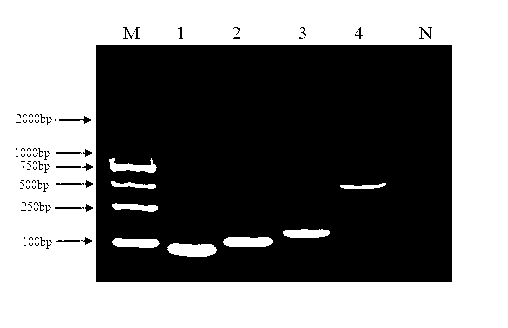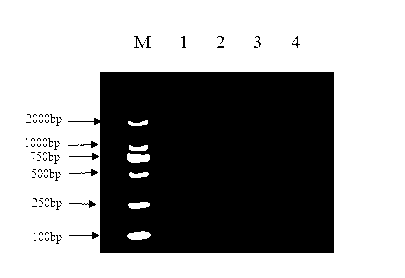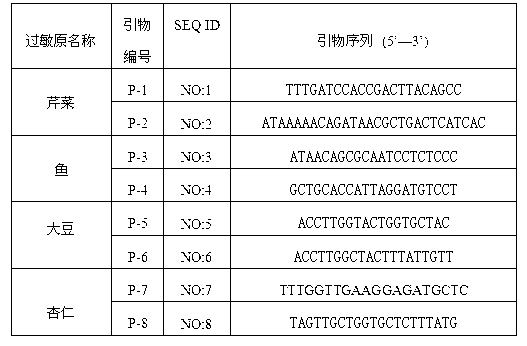Specific primer and kit for detecting common food allergens
A specific and allergen technology, applied in the PCR technology of four common food allergens of almond, soybean, celery, fish, and the sequence of PCR primers, can solve the problem of high allergenicity, and achieve high accuracy and method. The effect of simple and easy industrial production
- Summary
- Abstract
- Description
- Claims
- Application Information
AI Technical Summary
Problems solved by technology
Method used
Image
Examples
Embodiment 1
[0059] Example 1 : Genome Extraction
[0060] 1. Extraction of plant and animal tissue genomes (using TaKaRa MiniBEST Universal Genomic DNA Extraction Kit Ver.4.0 from Treasure Biological Company)
[0061] ① Take 2-30 mg of animal tissue or 25-100 mg of plant tissue, put it in a 2 ml tube, cut it into pieces as much as possible with scissors, and grind with liquid nitrogen for some hard tissues.
[0062] ② Add 180 μl of Buffer GL, 20 μl of Proteinase K and 10 μl of RNase A (10 mg / ml), warm in a 56°C water bath until the tissue is completely lysed (2 to 3 hours, and the difficult-to-lyse materials can be appropriately prolonged or even overnight. The plant material may have residual fibrous tissue that cannot be completely lysed and will not affect DNA extraction).
[0063] Note) During the warm bath, the sample can be taken out from time to time for shaking or pipetting to speed up the lysis.
[0064] ③ Add 200μl Buffer GB to the lysate and mix well by pipetting.
[006...
Embodiment 2
[0088] Embodiment 2: the design of primer
[0089] According to the sequences and references downloaded from NCBI, primers were designed for food allergen-specific genes. The primer sequences are shown in Table 1 below:
[0090] Table 1 Allergen-specific primer sequences
[0091]
Embodiment 3
[0092] Embodiment 3: Screening of specific primers
[0093] Primers were designed for food allergens celery, fish, soybean, and almond, and the primer sequences are shown in Table 1 (SEQ ID NO:1-SEQ ID NO:8). The specificity of other common food chicken, peanut, sesame and wheat was collected to verify the primers, and the source of food is shown in Table 2 below. Table 2 Foods tested
[0094] Allergen name specific gene source celery MTD Tianjin Development Zone Vegetable Market fish Mitochondrial 16S Tianjin Development Zone Vegetable Market soybean Lectin Tianjin Development Zone Vegetable Market almond Pru dul gene Tianjin Development Zone Vegetable Market chicken * Tianjin Development Zone Vegetable Market peanut * Tianjin Development Zone Vegetable Market Sesame * Tianjin Development Zone Vegetable Market wheat * Tianjin Development Zone Vegetable Market
[0095] The PCR system is ...
PUM
 Login to View More
Login to View More Abstract
Description
Claims
Application Information
 Login to View More
Login to View More - R&D
- Intellectual Property
- Life Sciences
- Materials
- Tech Scout
- Unparalleled Data Quality
- Higher Quality Content
- 60% Fewer Hallucinations
Browse by: Latest US Patents, China's latest patents, Technical Efficacy Thesaurus, Application Domain, Technology Topic, Popular Technical Reports.
© 2025 PatSnap. All rights reserved.Legal|Privacy policy|Modern Slavery Act Transparency Statement|Sitemap|About US| Contact US: help@patsnap.com



